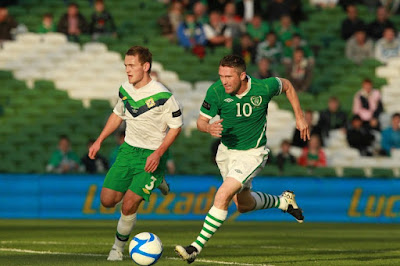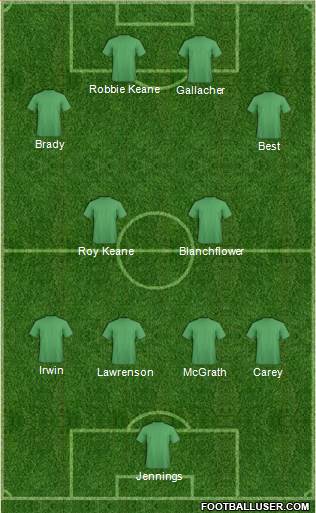This blogger Artur Yanturin of Russia copied many of my blog teams. This blog was one of them. It was my Russia All-Time Team here. His team was written in 2020, but mine was uploaded in 2014. This entry of his was written in October 21, 2020, but mine was uploaded in a few weeks before his 2020. Another entry of his was written in October 2020, but mine was uploaded in 2017. His entry of the Dutch-German rivalry between Real Madrid and Barcelona was written in 2020, but mine was uploaded in 2014. He also copied many many of my blog entries.
 |
| Ireland vs Northern Ireland 1978 |
I have also create all-time teams for both Ireland and Northern Ireland. My all-time team for the United kingdom is here.
English-born players capped by other national teams Ireland/Northern Ireland Combined Team 1986 World Cup
From 1882 to 1950, the name Ireland national team was used by the Irish Football Association (IFA). It consisted of players from the entire Ireland. After the partition of Ireland in the 1920s, another team was organized by Football Association of Ireland (FAI). They also competed with the name Ireland from 1937 and 1952. So two different team was playing as Ireland in the period and some players were playing for both teams. In 1953, the FAI was officially recognized as Ireland while the national team by IFA became Northern Ireland. Due to the complexity of Irish question, players who played for any of the Ireland national team are eligible to be on this team.
I do not know enough about Irish politics and the football world to see if it is possible to have a combined team for the Island of Ireland, but George Best famously called for an unified team throughout his career. Meanwhile, Irish Rugby Football Union and Hockey Ireland have created combined national teams for their sports without any problem.
 |
| N.Ireland vs Ireland |
Team
GK: Pat Jennings (N.Ireland)
Considered among the greatest goalkeeper of all-time. The prime of his career was spent with both Tottenham Hotspurs and Arsenal. In 1973 the Football Writers' Association named him as its footballer of the year. Three years later he won PFA's version of the award – he was the first goalkeeper to receive this accolade, and to this date remains only one of two, along with Peter Shilton. He earned 119 caps for Northern Ireland and went to two WC Finals.
 |
| Pat Jennings |
Shay Given started his career with Celtic in Scotland, but made his professional debut with Blackburn Rovers. He was remembered for playing with Newcastle United from 1997 to 2009. He was voted into PFA Team of the Year twice, 2001-2002 and 2005-2006. He later played for Manchester City, Aston Villa, Middlesbrough F.C. and Stoke. He earned 126 caps for Ireland. He played in the 2002 World Cup Finals and the European Championship in 2010 and 2016.
GK: Elisha Scott (N.Ireland)
Scott played 31 times for Ireland (IFA). He played for Liverpool from 1912 to 1934 and he remains as the longest-serving goalkeeper for Liverpool. His career was interrupted by the First World War. He won two English Championships with them. He was known for his rivalry with Everton's Dixie Dean. He also played with Belfast Celtic and Linfield.
RB: Billy McCracken (N.Ireland)
Billy McCracken was one of the most successful defender of his time. McCracken played for the English club Newcastle United from 1904 to 1924, helping them win three League titles and the FA Cup. He was known for setting the offside trap for the attackers. The offside rule was changed because of him.
RB: John Carey (Republic/N.Ireland)
He was also a dual internationalist, playing for and captaining both Ireland teams – the FAI XI and the IFA XI. In 1949, he was voted the FWA Footballer of the Year and in the same year captained the FAI XI that defeated England, becoming the first non-UK team to beat England at home. As a player Carey spent most of his career at Manchester United, where he was team captain from 1946 until he retired as a player in 1953.
CB/DM: Paul McGrath (Republic)
Paul McGrath is one of Ireland's greatest ever players. He played 83 times for Ireland. He appeared at the 1990 and 1994 World Cup Finals, as well as the Euro 1988. He played for St Patrick's Athletic and then, joined Manchester United in 1982. He had a run-in with Sir Alex who was the new manager at Manchester United and moved to Aston Villa in 1989 where he won the PFA Player of the Year in 1993. He later played for Derby County and Sheffield United.
 |
| Paul McGarth |
Richard Dunne was capped 80 times between 2000 and 2013. He went to the World Cup Finals in 2002, but did not play. He played at Euro 2012. For his club career, he spent ten years with Manchester City. He moved to Aston Villa in 2009 and then, Queens Park Rangers in 2013. He won Manchester City's Player of the Year award 4 straight times from 2004 to 2008, first player to win it 4 times.
 |
| Denis Irwin |
Belfast-born McMichael began his career at Linfield, before signing for Newcastle United in 1949. He remained at Newcastle until 1962, appearing 433 times. He was part of the team that won the 1952 FA Cup Final. At one point he was considered the best left-back in Britain and was a popular player amongst Newcastle United supporters. He represented Northern Ireland 40 times.
CM/DM: Roy Keane (Republic)
Roy Keane was the captain of Manchester United from 1997 to 2005, where he won one Champions' League, 7 Preimer League titles and 4 FA Cups. He was the PWA Player of the Year in 2000. At the international level, he had 67 caps. He played for Ireland at the 1994 World Cup Finals in the USA, but was sent home 4 years later before the start of the World Cup Finals in 2002. He later played for Celtic in Scotland after leaving Manchester United.
 |
| Roy Keane |
Giles started with Manchester United in 1957. After winning an FA Cup winner's medal under Matt Busby, he moved to Leeds United in 1963 where he played in midfield alongside Billy Bremner under Manager Don Revie. He also played for West Bromwich Albion, where he was the player-manager. He was voted as Ireland's greatest player at the UEFA Jubilee Awards in 2004. He was capped 59 times. From 1973 onward, he served as their player-manager.
CM/AM: Danny Blanchflower (N.Ireland)
Danny Blanchflower won the Double in 1961 with Tottenham Hotspurs. He won the FA Cup the following year, and then, a Cup Winners' Cup in 1963. He was the PWA Player of the Year in 1958 and 1961. He also played for Aston Villa and Barnsley before joining Hotspurs. He went to the World Cup in 1958, where North Ireland reached the quarterfinal.
LM/CM: Ronnie Whelan (Republic)
Ronnie Whelan played for the mighty Liverpool during the 1980's. He won one European Cup and 6 league titles. Whelan played for the Republic of Ireland national football team at one UEFA European Football Championship (1988) and two World Cups (1990 and 1994), turning out a total of 53 times for the national side between 1981 and 1995.
LW/RW: George Best (N.Ireland)
George Best was considered to be one of the greatest players ever played the game. He was voted #19 as the greatest European player by the UEFA Jublilee Poll. He was known for his "pop star" lifestyle. He was one of the "United's Trinity" that helped Manchester United to their first (and also first ever for an English club) European Cup in 1968. He won the PWA PLayer of the Year award and the Ballon d'Or that year.
 |
| George Best |
Billy Bingham was a childhood friend of Jackie Branchflower. He was at one point the cap record holder for Norther Ireland. He helped them to qualify for Sweden 1958, where North Ireland reached the quarter-final. He won a league title with Everton in 1963. His longest stint was with Sunderland, where he spent 8 years. He also had a lengthy career with Luton Town.
LW/AM: Liam Brady (Republic)
Liam Brady played over 200 times for Arsenal in the 1980's. He was the PWA Player of the Year in 1979. He was one of the few successful Irish players playing outside the UK. In 1980, he moved to Juventus, where he won two Series A titles in two seasons. He was replaced by Michel Platini, but he went on to play for Inter Milan and Ascoli in Italy. He made 72 caps for Ireland, but he never went to a major tournament.
 |
| Liam Brady |
RW/FW: Patsy Gallacher (N.Ireland/Republic)
Patsy Gallacher was nicknamed "Mighty Atom". He was considered one of the greatest Celtic's players ever. The 1925 Scottish FA Cup Final was called "the Patsy Gallacher" final after he scored a somersault goal. He played for Falkirk at the end of his career. He played 12 times for IFA (now called Northern Ireland) and one time for FAI (Republic of Ireland) in a game against Spain at the age of 41, the oldest ever debutant for their team.
CF: Joe Bambrick (N.Ireland)
Bambrick
began his career with Glentoran, before moving to Belfast rivals
Linfield in 1927. He scored a total of 286 league goals in just 183
games. From 1935 to 1938, he played for Chelsea. Bambrick
scored 12 goals in 11 games for Ireland (IFA), including six in one
game against Wales. His goal tally ensures that he still ranks as the
joint-fourth highest goalscorer for the Northern Ireland national side.
ST: Robbie Keane (Republic)
Robbie Keane is the all-time leading scorer and cap record holder for Ireland. He went to the World Cup Finals in 2002, and participated at Eyuro 2012 and 2016. He had played in Italy, Scotland, England, and the USA. Most of his stints were short, including a dream move to Inter Milan. His most famous stints was with Tottenham Hotspurs, where he won the League Cup in 2008. At the end of his career, he played in the MLS with LA Galaxy alongside Landon Donovan and David Beckham.
 |
| Robbie Keane vs Northern Ireland |
Frank Stapleton was Ireland's all-time leading scorer for a decade. He had 71 caps and captained Ireland at the Euro 1988, Ireland's first major tournament. He is best remembered for his time at Arsenal and Manchester United, where he won a single FA Cup for both clubs. He also played in Holland, Belgium and France after he left Manchester United.
ST: John Aldridge (Ireland)
John Aldridge is still the 6th highest goal scorer in the history of English football. He was best remembered with his career at Liverpool from 1987 to 1989. He joined the club as a replacement for Ian Rush. He linked up with Peter Beardsley and John Barnes to form one of the most exciting attacking lines in the club's history. He had 69 caps for the Republic of Ireland. He played in Euro 1988, and with 1990 and 1994 World Cup Finals.
 |
| John Aldridge |
 |
| Ronnie Whelan vs N.Ireland |



No comments:
Post a Comment